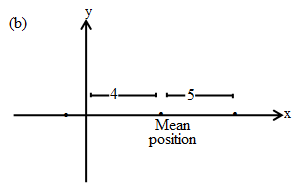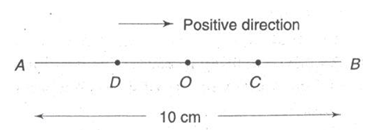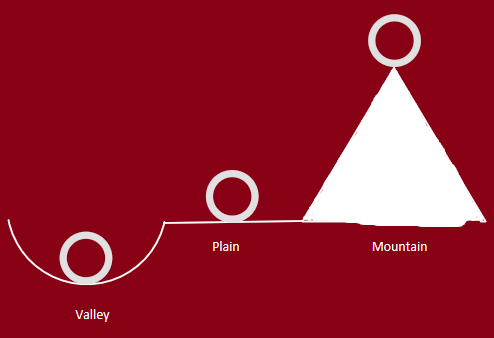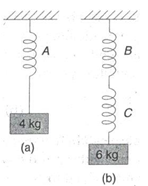12th Grade > Physics
OSCILLATION AND SIMPLE HARMONIC MOTION MCQs
Total Questions : 27
| Page 2 of 3 pages
Question 11. A spring stretches by 0.05 m when a mass of 0.5 kg is hung from it. A body of mass 1.0 kg is attached to one of its ends, the other end being fixed to the wall. The body is pulled 0.01 m along a horizontal frictionless surface and released. What is the total energy of the oscillator. Assume the string to have negligible mass and take g=10ms−2
Answer: Option A. -> 0.005 J
:
A
Force acting on spring = mg = 0.5 × 10 = 5N. This force extends the spring by 0.05 m. Therefore, the force constant is
k=50.05=100Nm−1
The angular frequency of horizontal oscillations is
ω=√km=√1001.0rads−1
The amplitude is A = 0.01 m. Therefore, total energy is
E=12mA2ω2=12×1.0×(0.01)2×(10)2=0.005J
Hence the correct choice is (a).
:
A
Force acting on spring = mg = 0.5 × 10 = 5N. This force extends the spring by 0.05 m. Therefore, the force constant is
k=50.05=100Nm−1
The angular frequency of horizontal oscillations is
ω=√km=√1001.0rads−1
The amplitude is A = 0.01 m. Therefore, total energy is
E=12mA2ω2=12×1.0×(0.01)2×(10)2=0.005J
Hence the correct choice is (a).
Answer: Option A. -> Periodic
:
A
Let's analyze the motion

The path that the falling ball takes is same. The ball starts from A and hits the ground at B then rebounds on the same path AB to reach A and falls again continuing the motion (A - B - A - B - - - -)
Now in the motion from A to B,
u = 0
s = -h ; a = -g
s=ut+12at2
−h=−12gt2
Time taken to fall t =√2hg
Time taken to go back is same t =√2hg
Total time = 2√2hg , which is the "time period for this motion”
for (A - B - A)
since the collision was elastic the ball comes back to same point and falls again.
It follows the same path and takes the same time.
Is the motion repeating itself?
Well what do we mean by "motion repeats itself”
(1) Take a reference point (any point)
(2) Note time period of motion. Let it be 'T'
(3) Note particles position and velocity from the reference point at any time t, (t < T)
(4) Again note particles position and velocity from reference point at time (T + t)
(5) The result for (3) & (4) should be same for a motion to be periodic. Also, the time period of every cycle should be same
The above motion is periodic
Let's check whether it's oscillatory
Oscillatory definition:
Oscillatory Motion:- If the body moves to and fro under the influence of a restoring force then its called oscillatory motion There is no point for stable equilibrium. So no point of restoring force
:
A
Let's analyze the motion
The path that the falling ball takes is same. The ball starts from A and hits the ground at B then rebounds on the same path AB to reach A and falls again continuing the motion (A - B - A - B - - - -)
Now in the motion from A to B,
u = 0
s = -h ; a = -g
s=ut+12at2
−h=−12gt2
Time taken to fall t =√2hg
Time taken to go back is same t =√2hg
Total time = 2√2hg , which is the "time period for this motion”
for (A - B - A)
since the collision was elastic the ball comes back to same point and falls again.
It follows the same path and takes the same time.
Is the motion repeating itself?
Well what do we mean by "motion repeats itself”
(1) Take a reference point (any point)
(2) Note time period of motion. Let it be 'T'
(3) Note particles position and velocity from the reference point at any time t, (t < T)
(4) Again note particles position and velocity from reference point at time (T + t)
(5) The result for (3) & (4) should be same for a motion to be periodic. Also, the time period of every cycle should be same
The above motion is periodic
Let's check whether it's oscillatory
Oscillatory definition:
Oscillatory Motion:- If the body moves to and fro under the influence of a restoring force then its called oscillatory motion There is no point for stable equilibrium. So no point of restoring force
Answer: Option D. -> πss
:
D
Displacement x = +0.01 m. Therefore, acceleration a=−1.0ms−2.
Now a = −ω2x
Or -1.0 =−ω2×0.01
Which gives, ω=10rads−1 . Therefore, T=2πω=π5s.
Hence the correct choice is (d).
:
D
Displacement x = +0.01 m. Therefore, acceleration a=−1.0ms−2.
Now a = −ω2x
Or -1.0 =−ω2×0.01
Which gives, ω=10rads−1 . Therefore, T=2πω=π5s.
Hence the correct choice is (d).
Answer: Option D. -> x = - ve, V = 0 , a = + ve
:
D
Displacement x = − 5 cm, i.e., x = − ve. Velocity at extreme points is zero. Acceleration is opposite to displacement. The a = +ve.
Hence the correct choice is (d)
:
D
Displacement x = − 5 cm, i.e., x = − ve. Velocity at extreme points is zero. Acceleration is opposite to displacement. The a = +ve.
Hence the correct choice is (d)
Answer: Option D. -> All
:
D
Condition for any object to be in translation equilibrium is that the net force on the object must be zero. Since it is given that at all the positions the ball is at equilibrium as the net force on it is 0.
:
D
Condition for any object to be in translation equilibrium is that the net force on the object must be zero. Since it is given that at all the positions the ball is at equilibrium as the net force on it is 0.
Answer: Option D. -> All
:
C
If a particle performs SHM with angular frequency 'ω' and amplitude 'A',then its displacement from mean position will be equal to x=Asinωt, if its initial phase is equal to zero.
Velocity will be equal to
v=dxdt=Aωcosωt→(1) and acceleration will be α=dvdt=−Aω2sin(ωt)→ (2)
From these equations, cosωt=vAω,sinωt=α−Aω2
Squaring and adding, v2A2ω2+α2A2ω4=1
If v is taken on the y-axis and α on the x-axis, then it will be an ellipse
:
C
If a particle performs SHM with angular frequency 'ω' and amplitude 'A',then its displacement from mean position will be equal to x=Asinωt, if its initial phase is equal to zero.
Velocity will be equal to
v=dxdt=Aωcosωt→(1) and acceleration will be α=dvdt=−Aω2sin(ωt)→ (2)
From these equations, cosωt=vAω,sinωt=α−Aω2
Squaring and adding, v2A2ω2+α2A2ω4=1
If v is taken on the y-axis and α on the x-axis, then it will be an ellipse
Answer: Option B. -> 3.0 cm
:
B
Let k be the force constant of each spring. The force F needed to extend the spring A by an amount x is
F=kxorx=Fk
In Fig, the springs are connected in series. Therefore, the force constant k’ of the combination is given by
1k′=1k+1k
Or k' = k2
If a force F’ is applied, the combination will extend by
x′=F′k′
Thus x′x=F′F.kk′= 64×kk/2=3
Or x' = 3x = 3×1cm=3cm
Hence the correct choice is (b).
:
B
Let k be the force constant of each spring. The force F needed to extend the spring A by an amount x is
F=kxorx=Fk
In Fig, the springs are connected in series. Therefore, the force constant k’ of the combination is given by
1k′=1k+1k
Or k' = k2
If a force F’ is applied, the combination will extend by
x′=F′k′
Thus x′x=F′F.kk′= 64×kk/2=3
Or x' = 3x = 3×1cm=3cm
Hence the correct choice is (b).
Answer: Option B. -> False
:
B
Here, the person is going to bed sharp at 10:00.
But what about his motion, if we take his bed as thereference he might take different paths every day. Someday he might follow.
(1) Bed - Bathroom - Bus stop - Office - Bus stop - Bed
(2) Bed - Bathroom - Cab - Office - Restaurant - Bed
So every day the path might be different, even if the path is same the velocity might be different (at the same time on different days)
Example: He might go to hisoffice every day but thespeed of abike and a car and a bus will be different.
Clearly, the motion is not periodic.
:
B
Here, the person is going to bed sharp at 10:00.
But what about his motion, if we take his bed as thereference he might take different paths every day. Someday he might follow.
(1) Bed - Bathroom - Bus stop - Office - Bus stop - Bed
(2) Bed - Bathroom - Cab - Office - Restaurant - Bed
So every day the path might be different, even if the path is same the velocity might be different (at the same time on different days)
Example: He might go to hisoffice every day but thespeed of abike and a car and a bus will be different.
Clearly, the motion is not periodic.
Question 20. A spring with no mass attached to it hangs from a rigid support. A mass m is now hung on the lower end to the spring. The mass is supported on a platform so that the spring remains relaxed. The supporting platformis then suddenly removed and the mass begins to oscillate. The lowest position of the mass during the oscillation is 5 cm below the place where it was resting on the platform. What is the angular frequency of oscillation? Take g = 10 ms−2
Answer: Option B. -> 20rads−1
:
B
It is clear that the separation between the two extreme positions of the oscillatingmass is 5 cm. Therefore, the equilibrium position 0 is 2.5 cm below the supporting platform. Inother words, force mg produces an extension y = 2.5 cm in the spring. If k is the force constantof the spring we have
m g=k y
or km=gy=1000cms−22.5cm=400s−1
The angular frequency ωof oscillation is
ω=√km=√400=20rads−1
:
B
It is clear that the separation between the two extreme positions of the oscillatingmass is 5 cm. Therefore, the equilibrium position 0 is 2.5 cm below the supporting platform. Inother words, force mg produces an extension y = 2.5 cm in the spring. If k is the force constantof the spring we have
m g=k y
or km=gy=1000cms−22.5cm=400s−1
The angular frequency ωof oscillation is
ω=√km=√400=20rads−1




















